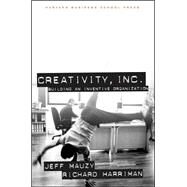Creativity Inc
, by Mauzy, Jeff- ISBN: 9781578512072 | 1578512077
- Cover: Hardcover
- Copyright: 4/1/2003
Introduction To survive and prosper in the long term, people in companies need to create and innovate. And they need to do so as regularly and reliably as they breathe. We begin our discussion of the need for creativity with a look at a successful company that recognized and met a serious new challenge by installing effective creative practices. In the late 1980s, Steelcase Inc., one of the largest U.S. manufacturers of office furniture, like its competitors was investing heavily in research and development in the hot area of its business, modular furniture units.1 "We had all evolved to the same perspective," says Mark Greiner, senior vice president of R&D at Steelcase. "There was an accepted framework in the industry, defined by three points on a triangle: high design, low cost, and customer relationship." Furniture companies had been differentiating themselves along the points of that triangle for some time. Steelcase was proudest of its customer relationships and placed most of its emphasis on maintaining that edge. "But in fact," Greiner says, "all the manufacturers, by watching each other, had gravitated over time toward safer and safer ground in the middle of the triangle defined by those three points." Thus, the differences between Steelcase and its rivals had grown almost nonexistent. "We were supposedly the most advanced office furniture company in the world, but in fact we were looking pretty much like our competition," he says. Worse, the customer was in motion. The exciting technological liberties of computing and communications made office design and furniture seem less urgent, even less relevant to some businesses. This realization didn't come suddenly, says Greiner. "But it started creeping more often into our conversations. Where's the difference? What's our value?" While the industry focused on a familiar, well-understood, highly defined world, the real world was changing. Steelcase needed to break free of many long-held beliefs about customer needs, beliefs that had become invalid. To reconnect with office furniture buyers, the company needed new ideas. Steelcase in the late 1980s qualified as a candidate for creativity and innovation, and through the course of the book, we'll follow the Steelcase story. But the Steelcase story is not unique. Corporate leaders in almost any business today need to know the fundamental elements for initiating and sustaining creativity and innovation. And they must understand the ways in which those elements work together. The speed of change in the economy has long since penalized companies and industries that try to coast with scattershot innovation or a single moment of creative serendipity. It now punishes even strategically astute companies that make serious but only sporadic, isolated, or conventional efforts at creativity and innovation. In the 1870s, Aaron Ward targeted quality-and-value-starved rural shoppers with a single-page, cash-only price list mailed to National Grange members. There was enough creativity and innovation in that business plan to start Montgomery Ward on a 125-year run. The only further innovation of any scope, however, was to build out stores across the country, a strategy that within a few decades caused the company to fall so far behind the pace of change in contemporary imagination and desires that customers stayed away. Still, 125 years is a good ride. Increasingly, the time period that an innovation can last is far shorter. Look at the home audio music business. The music box controlled that market for 100 years. The phonograph controlled the market for 70 years. Cassette tapes dominated for 25 years until the arrival of CDs. Now, after 10 years, CDs compete with mini-disks, DVDs, MP3, and the







